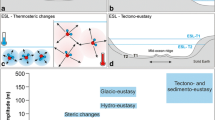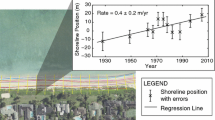Abstract
Observational results of the structure of the sea breeze over the urban and suburban areas of Tokyo for four summer days are presented.
On two of these days, the inland penetration of the sea breeze front could be clearly traced. In one case, the sea breeze was first observed along the shores of Tokyo Bay around 0900 JST, and propagated in three hours through the Tokyo City area, the width of which is about 20 km. It then advanced inland at a rate of 16 km h−1. Prior to the arrival of the sea breeze at the suburban site, the mixing height had remained at about 600 m for four hours. With the arrival of the sea breeze front, accompanied by an abrupt change in wind speed and direction, the mixing height increased sharply to 1700 m. It is suggested that this behavior and the structure of the front are intensified due to the urban effect, or the difference in the thermal characteristics between the urban and rural areas.
On the days without a sea breeze front, the land breeze system during the early morning was less intense, allowing the sea breeze to develop simultaneously with the inland valley wind and easily form a large-scale local wind system during the morning hours. In both cases, the vertical motion accompanying the local wind system works as a feedback mechanism to control the local winds by modifying the thermal and pressure fields.
Similar content being viewed by others
References
Fujibe, F.: 1985, ‘Air Pollution in the Surface Layer Accompanying a Local Front at the Onset of the Land Breeze’, J. Meteorol. Soc. Japan 63, 226–237.
Kimura, F.: 1985, ‘A Numerical Simulation of Local Winds and Photochemical Air Pollution (II): Application to the Kanto Plain’, J. Meteorol. Soc. Japan 63, 923–936.
Kondo, H.: 1989, ‘Description of NRIPR Mesoscale Model’, Report Nat. Research Inst. Pollution and Resources, No. 44.
Kurita, H. and Ueda, H.: 1986, ‘Meterological Conditions for Long-Range Transport under Light Gradient Winds’, Atmos. Environ. 20, 687–694.
Sherman, C. A.: 1978, ‘A Mass-consistent Model for Wind Fields over Complex Terrain’, J. Applied Meteorol. 17, 312–319.
Simpson, J. E., Mansfield, D. A., and Milford, J. R.: 1977, ‘Inland Penetration of Sea-Breeze Fronts’, Quart. J. Roy. Meteorol. Soc. 103, 47–76.
Takano, K.: 1977, ‘Three Dimensional Numerical Modelling of the Land and Sea Breezes and the Urban Heat Island in the Kanto Plain’, Dr.Sci. Thesis, Tokyo University.
Ueda, H., Mitsumoto, S., and Kurita, H.: 1988, ‘Flow Mechanism for the Long-Range Transport of Air Pollutants by the Sea Breeze Causing Inland Nighttime High Oxidants’, J. Applied Meteorol. 27, 182–187.
Yoshikado, H. and Yamamoto, S.: 1988, ‘Inland Transport of the Atmospheric Pollutants over Tokyo by the Sea Breeze’, Preprints of 14th Conference on Industrial Pollution, Agency of Industrial Science and Technology, Japan, 122–123 (in Japanese).
Author information
Authors and Affiliations
Rights and permissions
About this article
Cite this article
Yoshikado, H., Kondo, H. Inland penetration of the sea breeze over the suburban area of Tokyo. Boundary-Layer Meteorol 48, 389–407 (1989). https://doi.org/10.1007/BF00123061
Accepted:
Issue Date:
DOI: https://doi.org/10.1007/BF00123061




